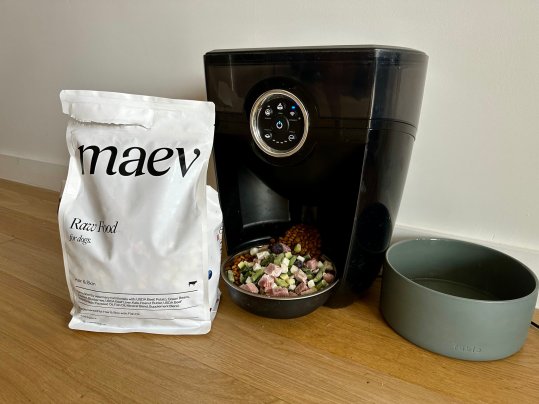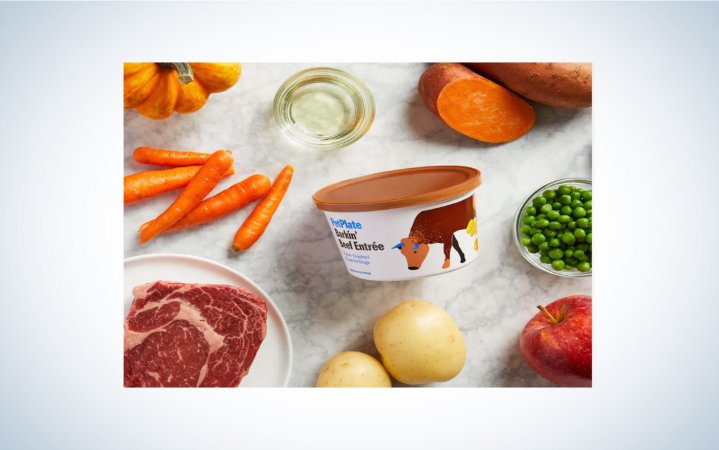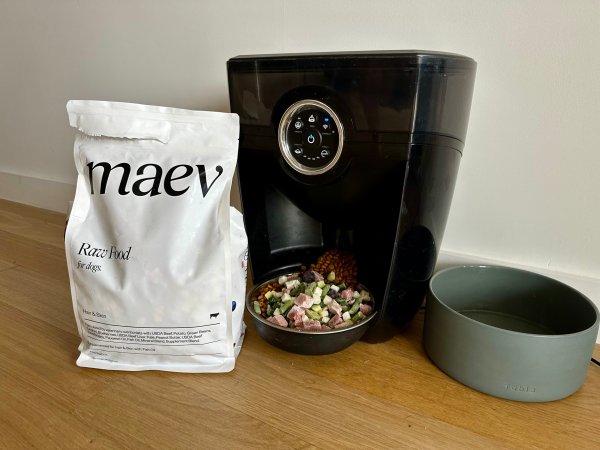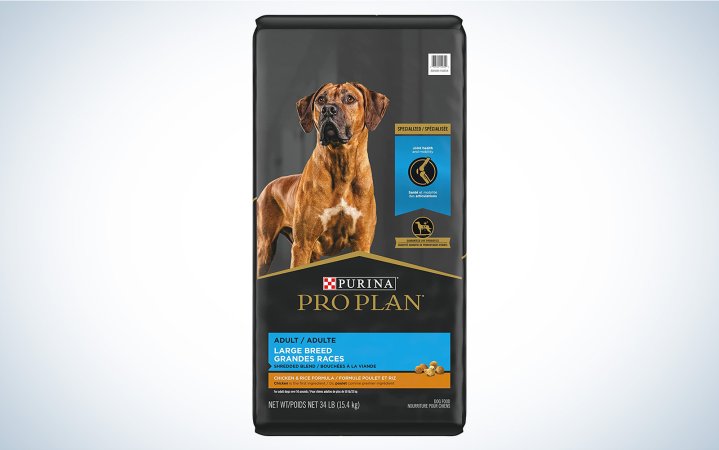We may earn revenue from the products available on this page and participate in affiliate programs. Learn more ›
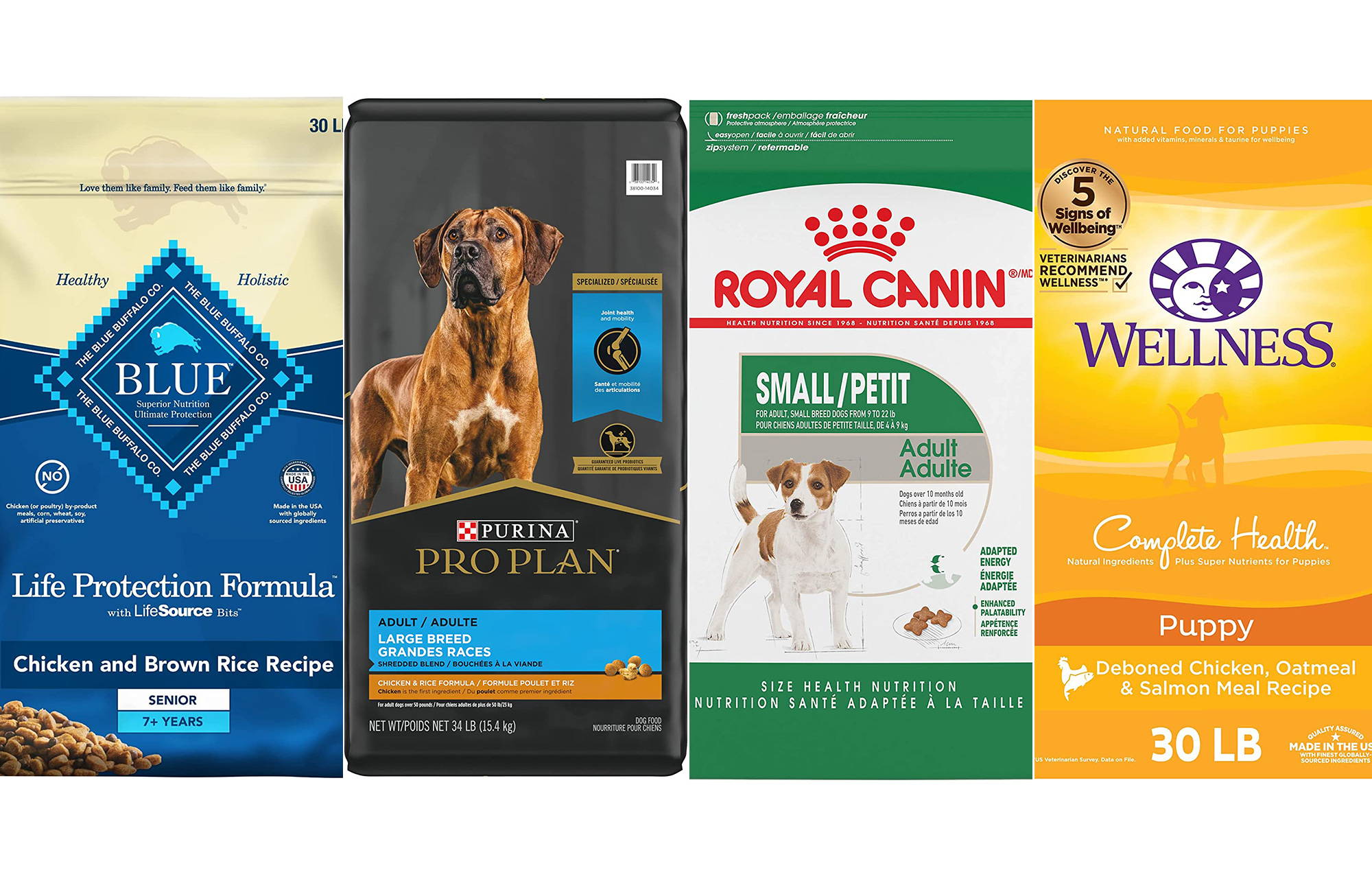
Caring for a dog requires a number of essential decisions, few of which carry more importance than choosing the right dog food. The pet food aisle at your local store is likely jammed with more options than you could possibly consider, which make navigating them nearly impossible on your own. Luckily, there are some basic variables that can point you in the right direction and get your pooch the chow they need to thrive. And while high-end dog foods may cost extra, they will likely pay off in the long run when it comes to vet bills, carpet cleaning costs, and nights spent sleeping instead of listening to dog with a rumbly stomach pacing around the house. Here are our picks for the best dog foods no matter what kind of canine you’re feeding.
- Best delivery service: PetPlate Dog Food
- Best raw: Maev
- Best for puppies: Wellness Complete Health Puppy
- Best for small breeds: Royal Canin Small Breed Adult Dry Dog Food
- Best for large breeds: Purina Pro Plan Joint Health Large Breed Dog Food
- Best for senior dogs: Blue Buffalo Dog Food for Senior Dogs, Life Protection Formula
How we chose the best dog food
We typically select a “best overall” pick for our buying guides, but that doesn’t really apply here. Every dog is different and suggesting one blanket food that’s the “best” for all of them just doesn’t work. Instead, we’ve broken up our selections by size, age, and delivery method. While these aren’t bargain-oriented options, we focused on brands that offer high quality without super premium pricing. You can spend five-star money on your pooch if you have the cash, but most of us don’t.
For our picks, I’ve relied on my extensive experience researching and writing about dog products for PopSci and other outlets. I’ve integrated suggestions from the vet that takes care of my dogs, though they didn’t want to specifically endorse any brands. Instead, they have provided some guidelines to look for.
We also considered editorial reviews, user feedback, nutrient comparisons, and brand reputation during our research process. The latter is especially important in this research as many dog food brands have experienced multiple recalls for safety issues in recent years.
The best dog food: Reviews & Recommendations
While we make specific picks for different varieties of dog, we recommend checking out all the picks since there’s often overlap when it comes to what’s best. Keep scrolling for a list of ingredients and variables you should consider when making your selection.
Best delivery service: PetPlate Dog Food
Best delivery service
PetPlate Dog Food
Pros
- Food gets delivered so you don’t run out
- High-quality ingredients
- Plans include complete nutrition options or just fresh food “toppers”
- Sturdy containers
- Healthy recipes
Cons
- Expensive
- Requires freezer storage
Specs
- Type: Fresh (frozen), and kibble
- Package size: Varies depending on variety
- Cost: Starts at roughly $2.50 per day for just cooked food or $6.50 per day for dry and cooked food
Running out of dog food feels like the biggest pet parenting fail. That’s not an issue with PetPlate. This delivery service offers several options, including a raw-only food topper that’s meant to mix with kibble. The company also sells its own fresh-baked kibble to go with the raw food topper, but it’s somewhat pricey compared to the dog food you’ll find at the store.
When you first sign up for the service, the site will guide you through a series of questions about your dog’s breed, size, allergies, weight, and any other variables that may affect its ideal food choice. The service then tweaks the selections and delivery intervals in order to provide an optimal diet.
The packages are sturdy and easy to store, even though they require freezing to stay fresh. The ingredients are excellent and you have access to a wide mix of nutrients. You’re going to pay more than you would if you just went to the store and bought the food, but the convenience can be worth it for some people. The added flexibility is also a definite plus for many.
Best raw: Maev
Best raw
Maev
Pros
- Extremely excellent ingredient list with meat, berries, peanut butter, and more
- Glucosamine for joint health
- Easy to store in the freezer
- Good for any breed
- Can mix with other foods to slow down consumption
Cons
- Expensive
Specs
- Type: Raw (frozen)
- Package size: Varies depending on variety
- Cost: $138 per 10-pound bag
The ingredients for this frozen raw dog food read like the menu at a delicious salad spot. It’s full of USDA-certified meat, kale, zucchini, green beans, peanut butter, and many other things you’ll actually recognize. This is most certainly not the cheapest option around, but it can work wonders for dogs with very sensitive stomachs or strong allergies.
In addition to the raw food itself, Maev also offers other products like bone broth toppers that can go with kibble and supplement bars that address specific issues. There’s a supplement bar for digestion, one for a shiny coat, one for joint health, and one to help with anxiety.
If you sign up for the subscription, you can easily change your delivery frequency, tweak your product selection, and cancel easily if you want to try something else. It’s expensive, but it’s worth it if you can accept the cost.
Best for puppies: Wellness Complete Health Puppy
Best for puppies
Wellness Complete Health Puppy
Pros
- Small chunks
- Glucosamine and calcium for bone and joint development
- Calcium and phosphorus for tooth development
- Staff nutritionists and vets
- Brand makes a full line so they can easily transition off of puppy food to adult food
Cons
- Expensive
Specs
- Type: Dry
- Package size: 5-, 15-, and 30-pound bags
- Cost: $66.48 for a 30-pound bag
Puppies require lots of energy in their food, but the wrong nutrient mix can make them chubby instead of well-fueled. Wellness boasts nutrition experts and vets on-staff in order to give credibility to their formulas. The pieces are small and easy for dogs to chew, but they’re crunchy and include essential supplements. Glucosamine helps with joints and bones. Other additives include probiotics (which can help developing stomachs adapt to their new food), antioxidants, and omega 3 fatty acids.
Once your puppy grows out of the puppy formula, Wellness offers a full line of foods that progress along with your pup. The puppy formula is usually appropriate for the first 8-14 months and then they can move up to the full-grown food.
Best for small breeds: Royal Canin Small Breed Adult Dry Dog Food
Best for small breeds
Royal Canin Small Breed Adult Dry Dog Food
Pros
- Small chunks that are easy to chew
- Limited phosphorous for kidney health in older dogs
- On-staff nutritionists for development
- Impeccable reputation
- Good for older small dogs
- Provides ample energy without causing weight gain
Cons
- Very expensive
Specs
- Type: Dry
- Package size: 14-pound bag
- Cost: $59.99 for a 14-pound bag
Royal Canin has a very well-earned reputation when it comes to dry dog food and that’s true for its small breed formula as well. Each piece of kibble is small and chewy, which dogs enjoy. The company has also tweaked the shape of each morsel in order to make it easy to chew, but good for the teeth. This food includes L-Carnitine, which the company claims provides the energy smaller dogs need without collecting as fat.
While this food is suitable for puppies (they are small after all), it has controlled levels of phosphorus specifically to help maintain kidney health in older dogs.
Best for large breeds: Purina Pro Plan Joint Health Large Breed Dog Food
Best for large breeds
Purina Pro Plan Joint Health Large Breed Dog Food
Pros
- Not as expensive as other high-end foods
- Several ingredients support joint health which can suffer in large breeds
- Suitable for sensitive stomachs (which can mean fewer farts)
- Chicken and rice formula doesn’t have a strong smell
Cons
- 18-pound bag goes quick with a big dog
Specs
- Type: Dry
- Package size: 18-, and 34-pound bags
- Cost: $71 for a 34-pound bag
Large dogs are fun, but they eat a ton of food. Plus, the food they eat can play an even larger role in their health because a fat large breed dog is bound to get joint issues and other problems that can be painful (and pricey) down the line.
This large-breed specific food doubles down on the joint health and bone support supplements. Heavier dogs abuse their joints, so that’s crucial here. It has a relatively gentle flavor profile, so it’s OK for many dogs with sensitive stomachs. Plus, it has extra protein, which is crucial for maintaining muscle, especially as the dog ages.
This isn’t the cheapest food around, which can be challenging with some large dogs eating several cups of food at every feeding. But, it’s a high-quality food that may keep your dog healthier longer and make up for its cost by saving you vet bills down the road.
Best for senior dogs: Blue Buffalo Dog Food for Senior Dogs, Life Protection Formula
Best for senior dogs
Blue Buffalo Dog Food for Senior Dogs, Life Protection Formula
Pros
- Relatively affordable for a high-end food
- Supplements to support joint health
- Extra protein, which older dogs require to maintain muscle
- Soft pieces are easy to chew
Cons
- Not good for overweight older dogs
Specs
- Type: Dry
- Package size: 5-, 15-, 30-, and 34-pound bags
- Cost: $57.50 for a 30-pound bag
You’ll notice several kinds of morsels in this kibble and that’s because Blue Buffalo has included its LifeSource bits in the mix. These vitamin-laden pieces include a wide variety of supplements, including vitamin D, L-Lysine, omega fatty acids, flax, and more. Keeping older dogs active is essential for keeping them healthy and this food provides plenty of energy to keep an old pooch moving. That said, if your older dog isn’t very active, this food can have too much energy stored and they can get fat if you don’t dial it in just right.
Blue Buffalo has nutrition experts and vets onboard to help with the development, so we have more trust in the ingredients and recipes than some others. This is also one of the more affordable options on the list, which is good since older dogs tend to require more expensive trips to the vet.
Things to consider when shopping for the best dog food
Brushing up on a few crucial variables and terms will help you get the right food for your dog and hopefully even save you some cash along the way.
Ingredients
It can be easy to fall into the same marketing traps human food endures when it comes to chow for your hound. After all, “natural,” is better, right? That’s not necessarily the case when it comes to dog food. Terms like “organic” and “natural” can be convincing on a package, but they’re hardly the only variables you should consider. You want to find ingredients that provide the nutrient and energy mix that your dog requires. Though our vet recommends we avoid foods with garlic powder, which some brands include to entice dogs to eat the food. It’s usually only present in small doses, but it’s unnecessary and can be harmful to the dog.
Supplements
Beyond the core ingredients you’ll find in the food itself, some companies include supplements for other purposes. For instance, some dog food includes phosphorus and calcium for tooth development. That’s great for some dogs, but phosphorus can also be hard on older dogs’ kidneys. That’s why many senior foods leave it out. You’ll also often see glucosamine for joint and bone health in foods for puppies, larger breeds, and older dogs. Ask your vet if those supplements are worth it for your pooch.
Cost
We’d love to truly splurge on our dogs and feed them food that would make the characters on The Bear applaud. But, that’s not always possible. You can get affordable dog food that still provides everything your dog needs, but make sure it’s not loaded with fillers or other garbage. Many companies sell raw food “toppers” that you can add to much cheaper dry food in order to balance out their diets. Once you’ve decided on a food combination, run it by your vet to make sure it provides everything your furry friend needs. Asking an expert is always the best way to get the info you need. Even if you have to pay for an appointment, you’ll get that money back and more in the long run, especially if it keeps your dog healthy.
Certifications
The Association of American Feed Control Officials (AAFCO) keeps track of what companies are putting into dog foods. It’s an independent organization, which is currently helping to evaluate the possibility of new federal standards regarding pet food. While this type of approval is important, it’s not as important as getting your own vet’s stamp of approval.
FAQs
While “natural” and “organic” ingredients are tempting to splurge on, the overall nutritional value of the dog’s food is more important than the specific ingredients most of the time. There are some ingredients that you want to avoid, like garlic, but reputable dog foods tend to avoid truly harmful ingredients. Obviously meat, vegetables, and grains are typically reliable sources of nutrients, but you need to get the mix right or even the most expensive dog food will do your dog a disservice. Talk to your vet.
If you want to provide your dog with raw food for nutrition, but you can’t spend a ton of cash every month, many companies offer raw food “toppers,” which add nutrition to typical kibble. Maev and PetPlate on this list both offer that type of product. Some vets will often recommend supplements like fish oil for omega 3s or glucosamine for joint health. Again, ask the vet. Always ask the vet.
Technically (and predictably) speaking, the difference between wet and dry food is the moisture content. Dry food will typically have less than 10 percent moisture, while wet foods will often contain more than 70 percent. But you’re probably wondering about the practical differences when it comes to your dog’s daily routine. To start, neither dry food nor wet food is objectively “better” than its counterpart. They each have their strengths and the only way to really know for sure which works better for your pooch is to (you guessed it) talk to your vet and then try it out.
Wet food can be good for dogs that are picky eaters or those that need to lose weight because they typically make a dog feel more satiated for a longer period of time. Dry food is typically cheaper, easier to store, and frankly a lot less disgusting than wet food.
Your specific dog’s needs and your own budget will often play the biggest role in determining which one is right for you. My dogs typically rely on a mixture of wet and dry and they’re very happy. Results always vary.
Final thoughts regarding the best dog food
- Best delivery service: PetPlate Dog Food
- Best raw: Maev
- Best for puppies: Wellness Complete Health Puppy
- Best for small breeds: Royal Canin Small Breed Adult Dry Dog Food
- Best for large breeds: Purina Pro Plan Joint Health Large Breed Dog Food
- Best for senior dogs: Blue Buffalo Dog Food for Senior Dogs, Life Protection Formula
If you want to ensure your dog lives a long, healthy life, choosing the right dog food is essential. This choice can also drastically affect your budget, your daily routine, and how often your living room gets bombarded with room-clearing farts. The best dog foods come from a reputable brand and provide all the nutrition your pup needs to stay healthy and active for the long haul.


